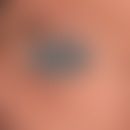Synonym(s)
DefinitionThis section has been translated automatically.
Inflammatory skin diseases, in the broadest sense of the word, caused or aggravated by optical radiation (daylight, UV and/or infrared rays), acute or chronic, inflammatory skin diseases based on genetic, (auto)immunological, allergic(photo)allergy, toxic(phototoxicity) or degenerative pathomechanisms.
ClassificationThis section has been translated automatically.
In addition to other, mostly (etiological) classifications, for reasons of clinical practicability, a classification according to the time course of skin symptoms in connection with sun exposure is useful:
- Immediate reactions (minutes to a few hours after light exposure):
- Delayed reactions (hours to a few days after light exposure):
- Phototoxic dermatitis
- Polymorphous light dermatosis
- Dermatitis solaris
- Photoallergic dermatitis
- Hydroa vacciniforme
- Phototoxic drug reactions (see Adverse drug reactions see below Photoallergen).
- Delayed reactions with chronic course (after days to weeks, persisting for months or years):
- Photoallergic drug reactions (see Adverse drug reactions s.c. photoallergic dermatitis, photoallergen).
- Actinic prurigo
- Chronic actinic dermatitis (see also persistent light reaction)
- Lupus erythematosus
- Dermatomyositis
- Pemphigus erythematosus
- Dyskeratosis follicularis (M.Darier)
- Hailey-Hailey disease
- Seborrheic eczema
- Pemphigus folicaceus
- Bullous pemphigoid
- Rosacea
- Perioral dermatitis
- Atopic dermatitis (exacerbation by UV rays in about 5% of patients)
- Mucinoses (SEM, plaque-like mucinoses)
- Pellagra
- Herpes simplex (glacial gangrene)
- Lichen planus (actinicus)
You might also be interested in
EtiopathogenesisThis section has been translated automatically.
A distinction is generally made with regard to aetiology:
- (auto)immunologically-mediated light dermatoses (formerly idiopathic forms). These include:
- Drug- or chemical-induced light dermatoses (endogenous, exogenous, see also photoallergen)
- diseases with defective DNA repair (genophotodermatoses) and
- photoaggravated diseases (see above).
DiagnosisThis section has been translated automatically.
Medical history (often clear and indicative of "light provocativeness"; if necessary, an etiological factor can be determined in a patient interview, e.g. a triggering photoallergen)
Clinical picture with the "at first glance" conspicuous, "light-emphasized" topographical distribution pattern (photodistribution)
Light stairs (see MED below)
Histopathology (if necessary, direct immunofluorescence to exclude an autoimmune disease)
Systemic provocation in case of questionable " adverse drug reaction"
Clinical-chemical examinations (e.g. porphyrin determinations; see porphyria below); autoimmunological laboratory parameters).
TherapyThis section has been translated automatically.
- The acute treatment of (auto)immunologically mediated light dermatoses (formerly idiopathic forms) as well as drug- or chemically-induced light dermatoses (endogenous, exogenous) consists mainly of anti-inflammatory measures. External preparations such as lotio alba and topical glucocorticoids are used, in severe cases also the systemic administration of glucocorticoids and antihistamines. Further UV-exposure or triggering agents (e.g. medication) should be avoided.
- The first priority for all light diseases is prevention through effective light protection.
- Avoidance of any UV-exposure: Any unnecessary stay in the sun with uncovered skin should be avoided; it must also be considered that in the shade a considerable amount of UV-radiation prevails. UVA radiation can easily penetrate window glass and windscreens!
- Protection through clothing: Covering the skin with clothing is an effective light protection with few side-effects, but it should be noted that fabrics can transmit considerable amounts of radiation depending on the fibre, dye and type of mesh. Use clothing that is as tightly woven as possible (e.g. polyester).
- Chemical sunscreens: By absorbing UV light in the corneal area, these substances prevent further penetration of the radiation into living cell layers. Added antioxidants additionally reduce the secondary photochemical reactions of the body's own molecules. Mainly in the UVB range, substances from the substance groups of paraaminobenzoic acid derivatives, salicylates, camphor derivatives, cinnamic acid esters and benzimidazole derivatives absorb. So-called broadband filters such as dibenzoylmethanes and benzophenones absorb both UVB and UVA. Especially for the frequently occurring polymorphic light dermatosis these broadband filters are of special importance but also cause photoallergies, which is why physical light protection filters are to be preferred from the photoallergenic point of view. Furthermore, due to the fixed maximum concentration of these substances, it is not possible to achieve an arbitrarily high light protection and therefore an additional physical light protection is helpful.
- Physical light protection agents: Pigments of titanium oxide, iron oxide or zinc oxide in a particle size of 10-60 nm absorb in the UV light range but hardly reflect visible light, so that these preparations have also become more cosmetically acceptable and can therefore be used on a wide scale. The formation of dangerous radicals can be completely prevented by coating the pigment granules or by doping, an intended "contamination" of the crystal lattice by ions of additives. As there is no approval requirement and no maximum limits have been set, light stabilizers with almost any protection value can be produced. The addition of antioxidants secondarily reduces the oxidative stress of the irradiated skin and thus further reduces the secondary erythema formation which occurs at least in the UVB range. Systemic UV protection products like antimalarials, cobilinogen, folic acid and nicotinamic acid have been rather disappointing so far. Tocopherol seems to favourably influence the course of polymorphic light dermatosis.
- Activation and increase of the body's natural light protection (pigmentation, light callosity) as well as immune modulation and immune suppression:
- Phototherapy: A phototherapy before the beginning of the sunny season or before the start of a holiday trip can avoid severely impairing episodes of illness and can thus be offered to patients with light dermatosis. This so-called "light-hardening" is preferably carried out with narrow-band UVB or also UVA1 (e.g. Urticaria solaris). In principle, one starts with very low UV doses and increases gently. The therapy usually lasts for 6-8 weeks.
- Photochemotherapy: If pure phototherapy fails and in cases of extreme photosensitization, systemic photochemotherapy ( PUVA therapy, systemic) can also be performed, which is the most effective prophylaxis in chronic actinic dermatitis.
- Anti-inflammatory preparations:
- Glucocorticoids: The use of glucocorticoids, external or systemic, should be limited to short-term therapy of acute photodermatosis and to the often difficult initial phase of photochemotherapy in chronic actinic dermatitis or photo-urticaria.
- Topical calcineurin inhibitors (e.g. tacrolimus) can be especially tried in chronic actinic dermatitis and actinic prurigo.
- Immunosuppressants: Azathioprine, Ciclosporin A or Chloroquine may be used in special situations, especially in the therapy of the subtypes of chronic actinic dermatitis.
- Thalidomide is the drug of choice for severe actinic prurigo.
- In dermatitis solaris, non-steroidal anti-inflammatory drugs such as ibuprofen p.o. (e.g. Ibuprofen ratiopharm) 400-600 mg/day can be used.
TablesThis section has been translated automatically.
Classification of light dermatoses according to their etiology
Etiology |
Diseases e.g. |
Acute phototoxic (exogenous, endogenous) |
|
| dermatitis bullosa pratensis | |
| Dermatitis, phototoxic | |
| solar dermatitis | |
| Porphyria cutanea tarda | |
| protoporphyria erythropoetica | |
| |
Allergic, (auto) immunological |
|
| Light urticaria | |
| hidroa vacciniformia | |
| Polymorphic light dermatosis | |
| |
Genetic (DNA repair defect) |
|
Progeria-like syndrome (Cockayne syndrome) | |
Degenerative (chronic exposure) |
|
Photoaging | |
Light engraved |
|
| Lupus erythematosus, cutaneous | |
| Rosacea | |
Bullous autoimmune dermatoses | |
Dyskeratosis follicularis (M. Darier) | |
Diagnosis |
Trigger |
Clinical picture |
Prophylaxis |
Therapy |
UVB |
metachronic formation of erythema, edema, vesicles, blisters, dandruff (typical inflammatory reaction, erythema in the early phase mediated by prostaglandins) |
Light protection (UVB sun filter) |
Internally (only for severe sunburn reactions): glucocorticoids, indometacin or ASS |
|
External: Moist compresses or hydrogels, glucocorticoids in the form of creams, foams or emulsions; lotio zinci to alleviate itching and to cool | ||||
UVA + phototoxic substances, e.g. methoxsalen, coal tar, tetracyclines |
similar to sunburn; reaction limited to the irradiated area |
discontinuation of phototoxic medication, light protection |
External: Glucocorticoid milk, creams (treatment analogous to toxic contact dermatitis). For large blisters Lotio zinci. Therapy as for 2nd degree burns (open blisters sterilely; application of antibiotic-containing corticoid creams). |
|
Photoallergic reactions |
UVA (UVB rare |
allergic reaction of type IV; severe itching and skin changes that extend beyond the irradiated area |
Avoidance of the allergen, light protection (UVA) |
External: Moist compresses, glucocorticoid emulsions or cream. |
Internally: In severe cases also systemic glucocorticoids. | ||||
UVA rays and/or UVB rays |
Papules, plaques or papulovesicles |
Light protection |
Existing skin changes respond well to local glucocorticoids (in severe cases also systemic glucocorticoids). |
Classification of light dermatoses according to clinical morphology
Clinical morphology |
diagnosis(s) |
sharply limited erythema, possibly edema, blisters |
Phototoxic dermatitis |
Eczema reaction |
acute: photoallergic dermatitis |
chronic: chronic actinic dermatitis | |
Actinic Prurigo | |
Papules, vesicles, plaques (not eczematous) |
polymorphic light dermatosis |
lupus erythematosus | |
blisters, crusts, scars |
hidroa vacciniformia |
Quadling |
Light urticaria |
Papules, nodules, ulcers |
Actinic Prurigo |
LiteratureThis section has been translated automatically.
- Fesq H et al. (2003) Management of polymorphous light eruption: clinical course, pathogenesis, diagnosis and intervention. Am J Clin Dermatol 4: 399-406
- Gambichler T et al. (2002): Role of clothes in sun protection. Recent Results Cancer Res 160: 15-25
- Lim HW, Hönigsmann H, Hawk JLM (eds.) (2007) Photodermatology. Informa Healthcare USA, Inc, New York
- Millard TP et al. (2000) The heritability of polymorphic light eruption. J Invest Dermatol 115: 467-470
- Neumann NJ, Lehmann P (2003) Photodermatoses during childhood. Dermatologist 54: 25-32
- O'Gorman SM et al (2014) Photoaggravated disorders. Dermatol Clin 32:385-398
- Paek SY et al (2014) Chronic actinic dermatitis. Dermatol Clin 32:355-361
- Schauder S (2003) Solar urticaria. Dermatologist 54: 952-958
- Valbuena MC et al (2014) Actinic prurigo. Dermatol Clin 32:335-344
- Wong SN et al (2001) Late-onset hydroa vacciniforme: two case reports. Br J Dermatol 144: 874-877
Incoming links (29)
B-clear; Calcium antagonists, side effects; Excimer laser; Hartnup syndrome; Hydroa vacciniforme; Hydroa vacciniforme-like lymphoproliferative disorder; Hyperpigmentation, circumscribed; Light protection; Light stabilizers; Occupational dermatoses; ... Show allOutgoing links (50)
Actinic Prurigo; Adverse drug reactions of the skin; Antihistamines, systemic; Antioxidants; Atopic dermatitis (overview); Azathioprine; Chloroquine; Chronic actinic dermatitis (overview); Ciclosporin a; Dermatomyositis (overview); ... Show allDisclaimer
Please ask your physician for a reliable diagnosis. This website is only meant as a reference.






